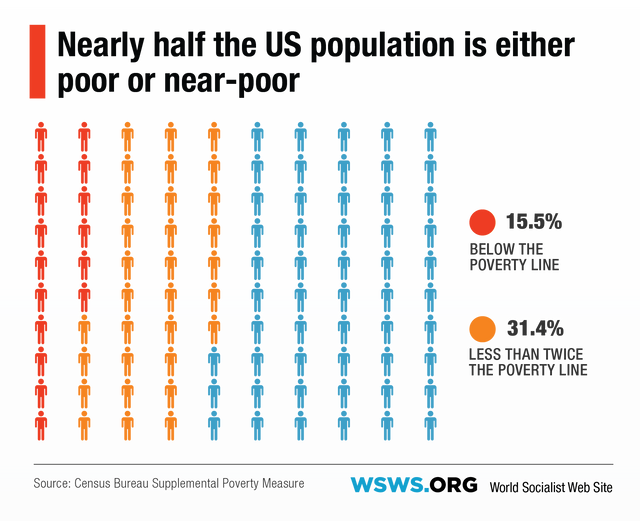Census Report: Half of Americans Poor or Near Poor

Forty-seven percent of Americans have incomes under twice the official poverty rate, making half of the country either poor or near-poor, according to figures released last week by the Census Bureau.
These figures are based on the Census Bureau’s Supplemental Poverty Measure (SPM), which takes into account government transfers and the regional cost-of-living in calculating the poverty rate. According to that calculation, there were 48.7 million people in poverty in the United States, three million higher than the official census figures released last month. The US poverty rate, according to the SPM, was 15.5 percent.
 Data from the Census Bureau report
Data from the Census Bureau reportThe release of these figures, as well as last month’s official poverty figures, have been greeted with silence in the media, despite the fact that the US is a mere two weeks away from a midterm election. As with every major social and political question, the issues of poverty and social inequality are being totally excluded from debate and discussion in the elections, and ignored by the two big business parties.
The figures follow the release of a series of reports and studies documenting the growth of social inequality in the United States. Last week, Credit Suisse reported that the top one percent of the world’s population controls nearly half of all wealth, and that the United States has nearly ten times more super-wealthy people than any other country.
The census figures “show that poverty is still a major problem in the US,” said Christopher Wimer, Co-Director of the Center on Poverty and Social Policy at Columbia University, in a telephone interview Tuesday.
He said the SPM begins with a slightly higher poverty threshold then the official poverty figure, and then adjusts it based on the local cost of living and the prices of necessities of life.
As a result, both the poverty rate and the number of people in poverty are slightly higher than under the official poverty figure. But the biggest difference is that the more- sophisticated supplemental measure shows the extent to which a much broader section of the population is struggling to make ends meet. “Because the supplemental poverty measure subtracts non-discretionary income, you get a lot more people hovering close to the poverty line,” Dr. Wimer said.
The official poverty threshold is calculated as “three times the cost of a minimum food diet in 1963,” adjusted for inflation. By that calculation, the poverty threshold of an adult living alone is $11,888, and an adult with two children is $18,769, both of which are absurdly low.
Since the SPM takes into account regional differences in the cost of living, it better reflects the true prevalence of poverty in high cost-of-living states, such as California, and cities, such as New York City.
“The supplemental poverty measure reflects the fact that the cost of living is much higher in many major metropolitan areas,” Dr. Wimer said. “Those areas also tend to have higher population densities, so that ends up affecting a lot of people.”
Based on the latest Census numbers, nearly one in four people in California lives below the poverty line. Using the supplemental measure, California has a poverty rate of 23.4 percent, compared with the state’s official poverty figures of about 16 percent.
Dr. Wimer said he and fellow researchers at Columbia University have followed a methodology similar to that used by the Census Bureau’s Supplemental Poverty Measure to study economic hardship among a representative sample of New York City residents.
They found that nearly a quarter of the city’s residents were in poverty—23 percent, compared to the official poverty rate of about 21 percent. Fifty-five percent of New York City residents had an income of below twice the poverty line.
Thirty-seven percent of New York City residents were affected by what the survey called “severe material hardships,” including “staying at a shelter, moving in with others or having utilities shut off.” The report added, “If we consider the number of New Yorkers who suffer moderate, if not truly severe, material adversity, the number climbs to 6 in 10 New Yorkers.”
Based on these findings, the report concluded, “Nearly two-thirds of New York City residents struggled to make ends meet at some point during 2012.”
The wealth of the super-rich, meanwhile, continues to soar, with the net worth of the Forbes 400 richest people in the United States surging 13 percent last year. Fifty-two members of the Forbes 400 resided in New York City, more than twice the number living in any other city.
Dr. Wimer noted that the Census SPM report shows the role played by government anti-poverty programs in keeping large sections of the population out of destitution. To the extent that there has been a decline in poverty in recent decades, “it is not driven by market income; the reduction has been coming from government policies and programs such as food stamps and unemployment insurance,” he said.
According to the Census SPM report, food stamps kept two percent of the population out of poverty in 2012, while unemployment insurance kept about one percent of the population out of poverty. The census figures reflect cutbacks in both of these programs in 2013.
With the end of federal extended unemployment benefits for the long-term unemployed at the end of last year, together with additional cutbacks to food stamps, the number of people affected by cuts to these vital anti-poverty programs will only increase.
Cuts to these programs have been implemented and supported by both the Democrats and Republicans. The Obama administration’s 2015 budget proposal, for example, calls for slashing the budget of the Department of Health and Human Services, which funds the Head Start preschool program, and the Department of Agriculture, which administers the food stamp program, by more than five percent.

